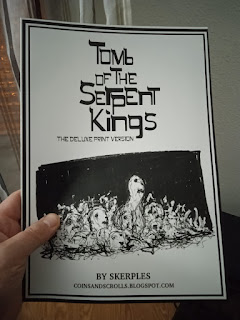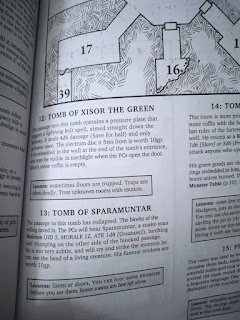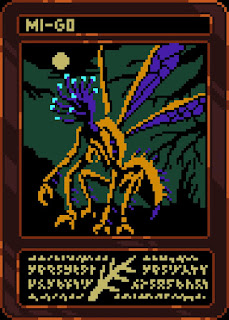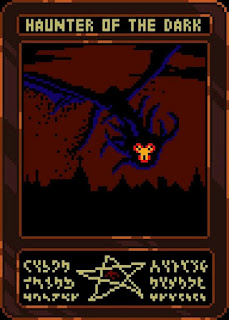Friday, November 26, 2021
A note on clerics and [review] of Tomb of the Serpent Kings
Monday, November 22, 2021
[review] Pokéthulu; my first game as GM ever
I drew a handful of pokethulus in a few minutes. I just sketched some shits on a paper, then added lightning, horns, extra eyes, extra anythings, fire, water, wings, tails and random weirdnesses and they were perfect. I was into the mythos while my players weren't; but I made a lot of references to them anyways, with one of the toughest pokemon being straight up ripped from Hellsing's Baskerville (one of the PCs captured without combat, with a lucky roll of a pokéball throw). There was a mechanic that incorporated making up quotes for the pokethulu fictional show in exchange for ¿successes? but we did away with that completely.
Edit: Some related link about somebody wanting to make a pokemon campaign focused on exploration.
Friday, November 19, 2021
[illustration] SidSothoth; H.P. Lovecraft pixel art
These are all from @SidSothoth at twitter. I found them when searching for images for an upcoming, lovecraft-related post, and could not resist saving them all. I love that aesthetics! Good art must be spread so everyone can enjoy it, and here it is! I think I am going to make a "tradition" of dumping works of inspiring artists from time to time.
Wednesday, November 10, 2021
Greatest Hits
I want to dump into this entry some nice things that I have found on the interwebs along the years. I intend to edit it periodically, as I stumble with shit, old and new. Everything you see here is something I want to have in handy, or has inspired me greatly.
Lets get organized:
/////Hard theory:
Breaking Out of Scientific Magic Systems (John H. Kim)
Philotomy's Musings (Philotomy)
Reckless Dweomer: Non-competitive classes, and why balance is a false guide
Soft D&D by False machine
Blorb Principles: I want to highlight the 3 Tiers Of Truth and the Wallpaper Salience
/////Combat:
Auto-Hits and Explaining D6 Damage (BX Blackrazor), both of them have sent me on uncountable hours of tormentous thought
Homebrew Homunculus posts on removing on damage rolls and rolled hit points.
Alex Schroeder series on map-less battle: Combat using 2 rows per side, no battlemap, theater of the mind, the blocking attacks rule and the 2 handed sword whirlwind.
Bastionland on combat that rolls ONLY initiative
Traverse Fantasy's calculations of Variable Damage versus Damage Reduction armor, very useful for any of those wanting to hack Into The Odd or similar games.
Combat progression as hit dice in OD&D
Hard ranged combat: -10 at medium range and -20 at far range, on Delta's D&D Hotspot
Hit Dice for monster parts, but monsters have an amount of combined HD at which they are defeated
/////Domain & Downtime:The quieter moments. "The intent is to hint at a wider and older world"
/////Magic:
/////Skills:
Methods & Madness: Target 18 for a correspondence from X in 6 Skills to a target 18 table
Correspondence between advantage and flat modifiers, a chart
Daimon games compilation 1 and compilation 2 of skill-related articles
90&30kingdoms on eliminating ability checks
Dice pool skill checks (xd6 under ability score)
The secret list of skills hidden in B/X
/////Classes:
Coins and Scrolls: OSR: Class: Knights
/////Tables/generators/aids:
A Character Background and Swag Generator for the Weird Dark Ages (gamepieces)
Random encounters for a night at the Inn, that also works for crowds. There is also another for city travel and another for rural areas (Chaudron Chromatique)
Bastionland on a way to create Planets or Hexes quickly or even Boroughs
/////Travel:
Preparing a Hexcrawl by Vile Cult of Shapes
Roll to move, by Alone in the Labyrinth
Dividing terrain types into three: Impassable, hard and easy, with or without path.
/////XP and advancement:
Dreamingdragonslayer on Diegetic Advancement Triggers and Diegetic genre emulation
Delta's apology of OD&D's XP for monster kill
/////Settings/scenarios:
The Pernicious Albion entries (Gloomtrain/Hexculture)
Elven Firefighters campaign (Evlyn Moreau)
NWO aliens (Foreign Planets)
Hopefishers (tabletop curiosity cabinet) It is intended to be a background class but its a whole village with customs, background and magic items.
Playing cute (hexculture/gloomtrain), interesting ideas about PCs improving their homebase while adventuring.
Usurped Kingdom Setup for any sandbox. Also there are versions of Thief Power Struggle, War or City Conspiracy which in the end are very similar lol. See also this procedure to make NPCS give missions (Evlyn Moreau)
The city of a thousand bath houses (lots of Ranma vibes here) also by Evlyn Moreau
/////About horses:
How to swim horses and cattle across a river
Some ideas on dog and horse quirks
/////The adventure:
Descriptive tracks by type of monster
Using the quieter moments to make the world feel large and old.
/////Rulesets/big houserulings:
2d6 fantasy game (Necropraxis)
JRPG basic (Necropraxis)
Simple Tabletop Skirmish 2d6 rules (What a Horrible Night to Have a Curse)
Searchers of the Unknown collection (Nicolas Dessaux & various authors)
Searchers of the Unknown Omnibus (DM Wilson's take on the above)
Tiny Goons (Evlyn Moreau)
Emp Dyn RPG | The Lizard Man Diaries. I'm particularly interested on its view making all attributes and skills "example attributes" and "example skills". What if all skills, stats, equipment, etc on an rpg book were just examples? and you could add more of them as soon as you needed them? In which direction would attribute lists evolve?
Goblins y Grutas (Esteban Juan Garcia de la Cruz) a really old school spanish game. Great musings about how rules light games worked better on the design notes, greatly ahead of their time.
Thieves can too, Motherfucker! (Johnstone Metzger)
World of dungeons (John Harper) and its resources tome
Dark Ages and Freeboting Venus part 1 and part 2 (Vincent Baker). Both are unfinished playtest versions but have interestingly unique visions on some things, IMO succeeding to create two oddly specific worlds and moods, at least on the reader.
How to be an adventurer (WWCD)This list is meant to be a personal collection, but feel free to anchor down in the comments any OSR/RPG links you want to keep
Tuesday, November 9, 2021
Current Houserules (Trow Fortress v1)
Saturday, November 6, 2021
XP to level one? or lowering the bar to level 2?
When playing old D&D (bx, od&d, etc )ou might have noticed that the XP needed to get from level 1 to 2 is the same that one would require to get from level 2 to 3. It contrasts with the further progression that doubles the XP required each level, up to level 9-10.
There is another approach, pointed up by an anonymous person I met on the internet. Which is to have each class start at level 1 with half of the XP they need to reach level 2, so the "double each level requirement" math is fixed. I loved this idea because it makes me think that level 1 characters have a "past" that gave them some XP and made them into the class they have now. This would explain why some NPCs have no class, and the ones they have it its because they bought it with some XP
Curiously, as each class has its own XP requirements, it can be interpreted on some ways. Thieves require less XP and magic users require more, so its a good reason in-game for why there are much more thieves than wizards in the world.
To put it in another way, you can have a 0 level character with no XP and no class. Then, when he gets the XP required to buy the first level of the class that he wants to become (1000 for a fighter, 600 for a thief, 1250 for a magic user), he can "buy" it. If you are not into 0 level play, you can just have the PC start with said XP amount straight away.
Note that they will need double that amount to get into level 2, so we are running into "levels with same requirements" again. What a mess haha. Well, we can fix it rounding them down a little: 700 for the fighter, 500 for the thief and 1000 for the magic user.







































